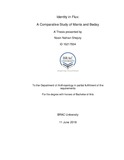| dc.contributor.advisor | Alam, S. M. Shamsul | |
| dc.contributor.author | Shejuty, Nosin Nahian | |
| dc.date.accessioned | 2018-06-28T07:11:37Z | |
| dc.date.available | 2018-06-28T07:11:37Z | |
| dc.date.copyright | 2018 | |
| dc.date.issued | 2018-07-11 | |
| dc.identifier.other | ID 15217004 | |
| dc.identifier.uri | http://hdl.handle.net/10361/10295 | |
| dc.description | This thesis is submitted in partial fulfilment of the requirements for the degree of Bachelor of Social Science in Anthropology, 2018. | en_US |
| dc.description | Cataloged from PDF version of thesis. | |
| dc.description | Includes bibliographical references (page 66-67). | |
| dc.description.abstract | Manta is one of the oldest traditional occupational communities who live in the southwest region of Bangladesh. This traditional occupational community lives on a boat which is severed as their own residence where they have their household furniture. They were born here, raised here and many of them also died inside that small boat. Fishing is the only profession of these people and only source of earning. All the members of the family, including children and women, go to catch fishes. Their sorrow, happiness everything lies on the boat. They have their own socio-cultural and occupational status, religious beliefs and traditions as a distinct culture. On the other hand, there is another traditional occupational community who are called Beday. They are the nomadic people whose life is also connected with the boat. They are also known as river gypsies. Beday people do different kinds of business, like- selling jewelry, catching a snake, treating snake bitten patients; some of them also catch fishes, plays with monkey or parrot, do circus, fortune teller and other works. If we look at Manta and Beday community we will be able to see that both of their social-cultural uniqueness, lifestyle, tradition, language and culture is similar in some way or other. On the other hand, there is a particular Beday community who lives in Savar who call them Manta. This research was conducted to understand whether there is any difference between Beday and Manta community or not; whether they are an offshoot of each other or not; Lastly, to know about both of their tradition and socio-cultural uniqueness through which this traditional occupational community living in this region over hundreds of years. | en_US |
| dc.description.statementofresponsibility | Nosin Nahian Shejuty | |
| dc.format.extent | 67 pages | |
| dc.language.iso | en | en_US |
| dc.publisher | BRAC Univeristy | en_US |
| dc.rights | BRAC University theses are protected by copyright. They may be viewed from this source for any purpose, but reproduction or distribution in any format is prohibited without written permission. | |
| dc.subject | Beday | en_US |
| dc.subject | Ethnic group | en_US |
| dc.subject | Manta | en_US |
| dc.subject | Snake charmer | en_US |
| dc.title | Identity in flux: a comparative study of Manta and Beday | en_US |
| dc.type | Thesis | en_US |
| dc.contributor.department | Department of Economics and Social Sciences, BRAC University | |
| dc.description.degree | BSS in Anthropology | |

